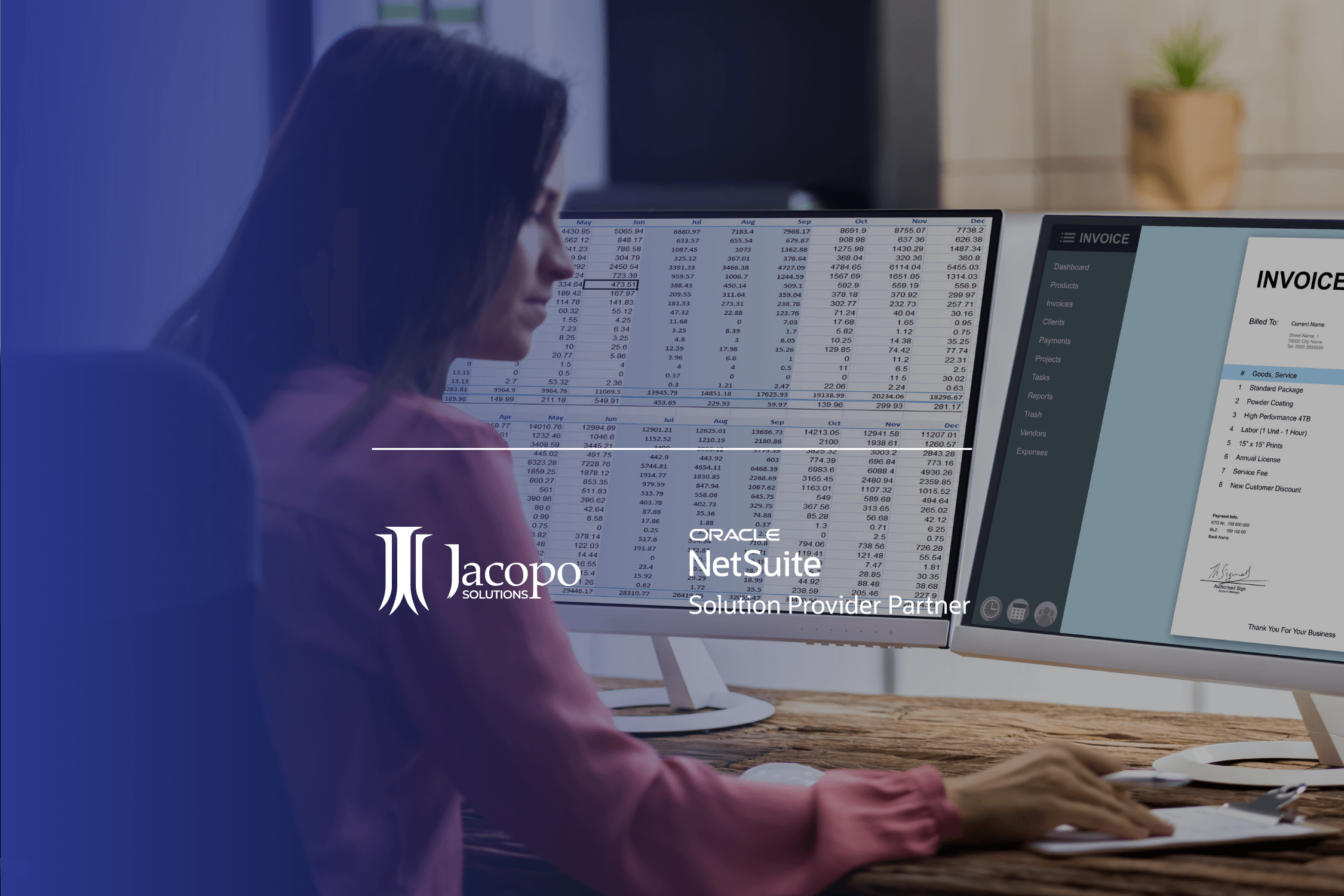
NetSuite AP automation makes accounts payable easier by removing manual entries and errors.
NetSuite AP automation simplifies accounts payable by eliminating manual tasks and improving accuracy and cash flow management.
In this article, I’ll discuss automated invoice capture, customisable approval workflows, and secure payment processing, all of which reduce manual effort and increase efficiency. I’ll also discuss how we at Jacopo implement best practices such as initial assessment, gradual rollout and comprehensive training, which are key to successful adoption and getting the most out of AP automation.
Understanding NetSuite AP Automation
NetSuite AP automation reduces manual work in accounts payable by replacing time-consuming tasks with digital workflows. This simplifies processes and improves accuracy and speed in financial operations.
AP automation helps reduce late payments and duplicate invoices. It impacts finance teams by speeding up their work, reducing workload and improving accuracy. Digital invoice processing minimises the need for physical documents, streamlines the entire accounts payable process and provides visibility into the financial cycle.
Features of NetSuite AP Automation
NetSuite AP Automation has features that increase efficiency and accuracy in financial operations. The main features are Automated Invoice Capture, Approval Workflows and Payment Processing. Each of these features plays a big role in transforming the invoice-to-pay process, reducing manual effort and increasing operational efficiency.
Automated invoice capture
NetSuite uses advanced Optical Character Recognition (OCR) technology to automatically process vendor invoices, reducing manual data entry to almost zero. This technology efficiently extracts information from invoices and can even use machine learning to improve over time. Automating invoice capture allows businesses to process invoices faster and more accurately, reducing errors and delays.
Automating invoice capture eliminates manual reconciliation and simplifies accounts payable. This results in faster invoice processing, invoice data management and payment execution, hence overall financial efficiency.
Approval workflows
NetSuite has customisable approval workflows that improve the approval process. These workflows speed up invoice reviews by simplifying approvals and reducing manual tasks. Automated alerts and reminders prevent delays and ensure invoices are processed and paid on time.
So businesses can have better relationships with vendors and avoid late payment penalties.
Payment processing
NetSuite’s payment processing feature gives you control and security over user transactions. Payment options within NetSuite are ACH, checks, and virtual credit cards, which give you flexibility when paying vendors. Payments can be initiated directly from the platform, streamlining the payment process and reducing manual intervention.
NetSuite requires you to sign up for an HSBC bank account for vendor payments, ensuring secure and efficient transactions. This feature simplifies payment execution and improves financial operations by giving you better control over outgoing cash flows and compliance to financial regulations.
Benefits of using NetSuite AP Automation
The benefits of NetSuite AP automation include increased efficiency, improved accuracy, cash flow management and cost savings. NetSuite consolidates multiple AP functions into one platform, simplifies accounts payable and reduces reliance on third-party tools.
Enhanced Efficiency and Accuracy
NetSuite AP automation boosts productivity by reducing time spent on manual tasks like invoice processing. Direct payment execution without external software increases efficiency and reduces human error.
Assessing the current accounts payable process helps you identify inefficiencies and areas that can be automated. Pinpointing these bottlenecks is crucial to improving efficiency and accuracy in financial operations.
Improved cash flow management
Real-time insights from AP automation enable you to manage cash flow better, capture early payment discounts and optimise outgoing cash flows. Automating payment scheduling reduces the risk of late payments and ensures financial obligations are met on time. This visibility into cash flows gives you more strategic financial planning, so you have the information you need to make decisions about your AP automation.
Automating accounts payable helps you better manage financial operations, make timely payments, and optimise cash flow. This is key to economic stability and long-term success.
Cost savings
Automating accounts payable can result in significant cost savings by reducing potential reconciliation errors and manual processing costs. Reduced manual tasks mean fewer resources needed for invoice processing, hence cost savings for businesses of all sizes.
Automating AP processes reduces physical document storage and operational overhead of manual processes. These cost savings, combined with increased efficiency and accuracy, make AP automation a good investment for financial operations.
Comparing NetSuite and Bill.com for AP Automation
When it comes to AP automation, both NetSuite and Bill.com have robust solutions, but they are tailored to different needs and preferences. Understanding the differences in functionality, cost, and integration is key to making an informed decision about which platform is right for your business.
Functionality Comparison
NetSuite’s AP automation integrates invoice processing as part of its full ERP system, making it a good choice for larger companies with complex financial management. Bill.com has a user-friendly interface to automate invoicing and payments, and operations can be set up in less than a month.
Bill.com excels in user experience and quick setup. NetSuite has a more integrated approach to financial management, which may be better for larger companies. However, NetSuite relies on features from partner tools to offer complete functionalities, which might be a consideration for some companies.
Cost analysis
NetSuite doesn’t charge additional subscription fees for its AP automation features, which can lower overall costs due to reduced manual processing. Bill.com has separate software costs, typically a flat monthly fee, which can be more predictable for smaller companies.
However, NetSuite’s monthly cost is generally three times higher than Bill.com’s for similar features but with better scaling capabilities. So, you’ll need to balance cost with growth scalability.
Integration Capabilities
NetSuite’s integration capabilities enhance its functionality by allowing seamless communication between applications and systems. NetSuite’s strong API integration allows data sharing and synchronisation, including invoice images and expense line items.
Bill.com, on the other hand, may have integration challenges due to limited compatibility with some legacy systems. Integration with platforms like AvidXchange and NetSuite supports workflow efficiency and data accuracy in the accounts payable process, making NetSuite a strong contender for companies looking for full AP automation solutions.
Integration challenges with AP automation tools
Integrating a new AP automation system with existing financial systems can have compatibility issues due to different structures and functions. These issues can lead to data silos and operational disruption if not appropriately managed.
Data migration issues
Migrating data from legacy systems to new AP automation solutions often involves challenges like data format inconsistencies, sensitive financial data issues and historical data loss. Successful migration requires planning, data mapping, cleansing for accuracy and backup strategies.Data corruption during migration can occur and impact overall integrity. Migrating data in phases ensures data alignment with the new system.
Customisation needs
Customisation in AP automation tools fits the software to specific business processes and requirements. Unique approval workflows, payment processing options and reporting formats often require customisation.
Addressing customisation needs improves the implementation experience and overall success of AP automation. Challenges include system integration and not blocking updates.
Ongoing maintenance and support
Ongoing support and maintenance keep the AP automation system running post-implementation, ensuring tools adapt to business changes.
NetSuite users get ongoing support and maintenance, which includes managing customisations, user permissions and system operational tasks to ensure consistency. Continuous education on new features and updates is key to maintaining workflows and adapting to changes.
Best practices for implementing NetSuite AP Automation
Implementing NetSuite AP Automation requires a strategic approach. Follow best practices to ensure a smooth transition and maximise benefits.
Initial assessment
When choosing AP automation software, companies should consider integration, scalability, user experience, advanced features, security, vendor reputation, cost, support, and customisation. A thorough initial assessment identifies the right solution for specific needs and workflows.
Evaluating existing workflows is key to identifying bottlenecks and areas to automate. Understanding these helps in choosing a solution that addresses unique challenges and requirements.
Phased rollout
A phased approach to automation helps teams manage change effectively and minimise disruption. Automating in stages allows teams to adapt to new processes and reduce resistance to change.
This phased rollout ensures issues can be addressed quickly, making the transition smoother and more manageable for the entire organisation.
Training and adoption
Training maximises the benefits of NetSuite AP automation. Encouraging staff to adopt new tools increases productivity and engagement with new workflows. Resources for different professions and learning styles make training accessible to all team members.
Investing in thorough training enables a team to use the software effectively, leading to increased productivity and efficiency. Free resources can start the learning process; enrolling in a comprehensive training course accelerates it. This ensures all team members are familiar with NetSuite functionalities and contributes to the success of the automation project.
Let Jacopo handle your NetSuite AP Automation
NetSuite AP Automation is a game changer for businesses looking to optimize their accounts payable.
We at Jacopo can help automate manual tasks, enhance accuracy, and improve cash flow management; NetSuite provides significant benefits that can lead to substantial cost savings and operational efficiency.
Using these technologies and following best practices for implementation will ensure a smooth transition, maximize the benefits of AP automation, and achieve a more efficient and financially stable organization.
Frequently Asked Questions
What are the key features of NetSuite AP Automation?
NetSuite AP Automation has Automated Invoice Capture, Approval Workflows and streamlined Payment Processing to make accounts payable more efficient and accurate. These features simplify the entire AP process and reduce manual work and errors.
How does NetSuite AP Automation improve efficiency?
NetSuite AP Automation minimises manual tasks and errors, automates invoice processing, and streamlines payment workflows to increase productivity and accuracy.
What are the cost benefits of using NetSuite AP Automation?
NetSuite AP Automation reduces manual processing costs and errors, which leads to big savings and less physical document storage.
How do NetSuite and Bill.com compare in terms of functionality and cost?
NetSuite is a complete financial management system that is more expensive. Bill.com is user-friendly and has predictable subscription fees. So, if budget is a concern, Bill.com is the better choice. If functionality is more important for you, consider NetSuite.
What are the common challenges in integrating AP automation tools?
Integrating AP automation tools has challenges, such as data migration difficulties, customisation needs and ongoing support requirements. Addressing these issues is key to a smooth implementation and system performance.
